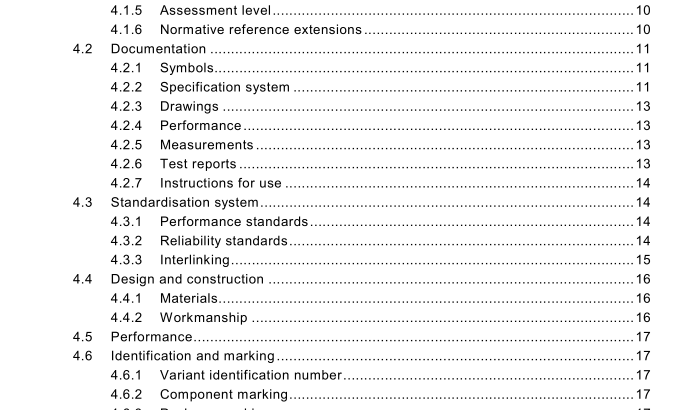IEC 61073-1:2009 pdf download – Fibre optic interconnecting devices and passive components – Mechanical splices and fusion splice protectors for optical fibres and cables – Part 1: Generic specification
4.3 Standardisation system
4.3.1 Performance standards Performance standards contain a series of test and measurement sets (which, depending on the requirements of that standard, may or may not be grouped into a specified schedule) with clearly defined conditions, severities and pass/fail criteria. The tests are intended to be run on a “once-off” basis to prove a given product’s ability to satisfy the “performance standards” requirement. Each performance standard has a different set of tests and/or severities (and/or groupings), and represents the requirements of a market sector, user group or system location. A product that has been shown to meet all the requirements of a performance standard can be declared as complying with a performance standard, but should then be controlled by a quality assurance /quality conformance programme.
4.3.2 Reliability standards Reliability standards are intended to ensure that a component can meet performance specifications under stated conditions for a stated time period. For each type of component, the following need to be identified (and appear in the reliability standard):
– failure modes (observable general mechanical or optical effects of failure);
– failure mechanisms (general causes of failure, common to several components); and
– failure effects (detailed causes of failure, specific to component).
These are all related to environmental and material aspects.
Initially, just after component manufacture, there is an “infant mortality phase” during which many components would fail if they were deployed in the field. To avoid early field failure, all components may be subjected to a screening process in the factory, involving environmental stresses that may be mechanical, thermal or humidity-related. This involves inducing known failure mechanisms in a controlled environmental situation to occur earlier than would normally be the case in an unscreened population. For those components that survive (and are then sold), there is a reduced failure rate, since these mechanisms have been eliminated. Screening is an optional part of the manufacturing process, rather than a test method.
It will not affect the “useful life” of a component, defined as the period during which it performs according to specifications. Eventually other failure mechanisms appear, and the failure rate increases beyond a specifically defined threshold. At this point the useful life of the component ends and the “wear-out region” begins, and the component must be replaced. At the beginning of the useful life, performance testing on a sampled population of components may be applied by the supplier, by the manufacturer, or by a third party. This is to ensure that the component meets performance specifications over the range of intended environments at this initial point in time. Reliability testing, on the other hand, is applied to ensure that the component meets performance specifications for at least a specified minimum useful lifetime or a specified maximum failure rate. These tests are usually carried out by utilising the performance testing, but increasing duration and severity to accelerate the failure mechanisms. A reliability theory relates component reliability testing to component parameters and to lifetime or failure rate under testing. The theory then extrapolates these to lifetime or failure rate under less stressful service conditions. The reliability specifications include values of the component parameters needed to ensure the specified minimum lifetime or maximum failure rate in service.
4.3.3 Interlinking The standards currently under preparation are given in Figure 1 . A large number of the test and measurement standards are already in place. The quality assurance/qualification approval standards produced under the banner of the IECQ have already been in place for many years. As previously mentioned, other alternative methods of quality assurance/quality conformance are being developed under the rubrics of Capability Approval and Technology Approval which are covered by IEC QC 001 002-3 and IEC Guide 1 02. With regard to performance and reliability standards, the matrix given in Table 3 demonstrates some of the options available for product standardisation once these two standards are in place.
